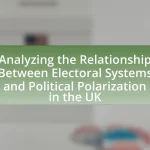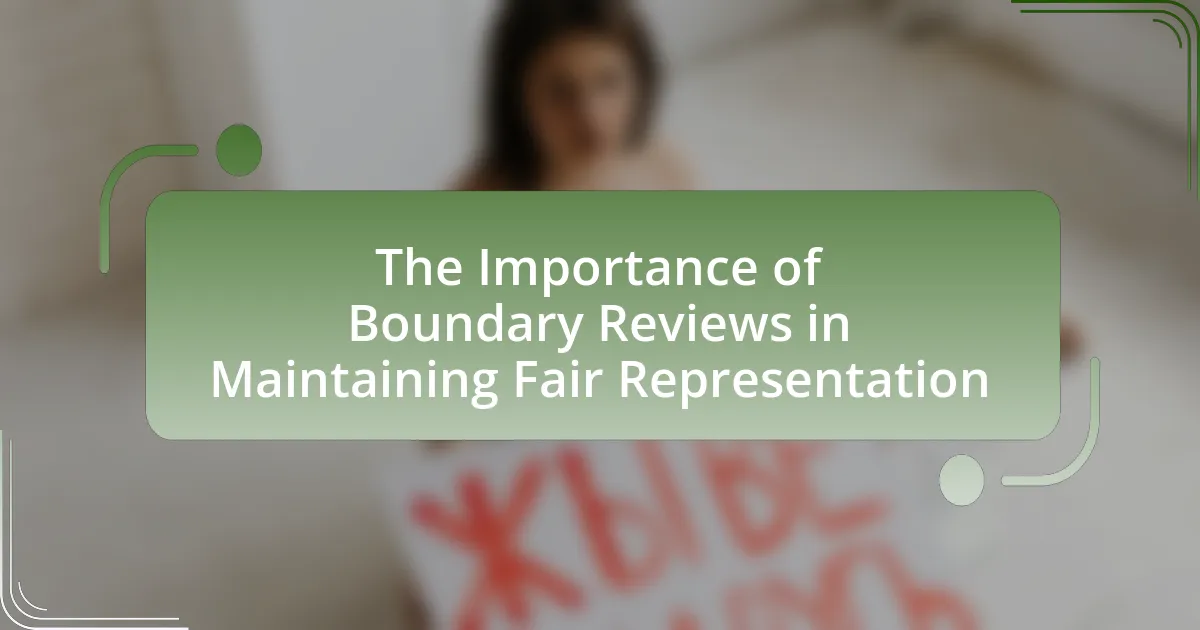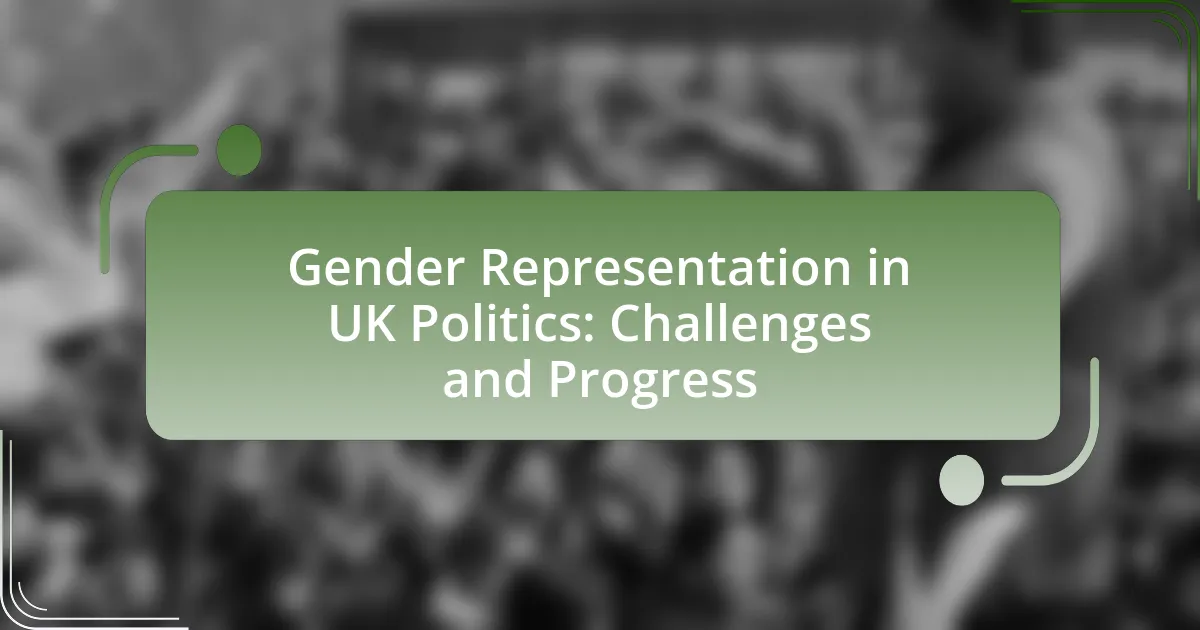The First Past the Post (FPTP) system is the electoral mechanism employed in UK general elections, where the candidate with the most votes in a constituency wins, regardless of achieving an absolute majority. This article examines the functioning of FPTP, its historical context, and its implications for political representation, voter behavior, and party dynamics in the UK. Key criticisms of the system include its tendency to produce disproportionate outcomes, disenfranchisement of voters, and the promotion of tactical voting. Additionally, the article explores potential reforms to enhance electoral fairness and representation, highlighting alternative voting systems that could reshape the political landscape in the UK.
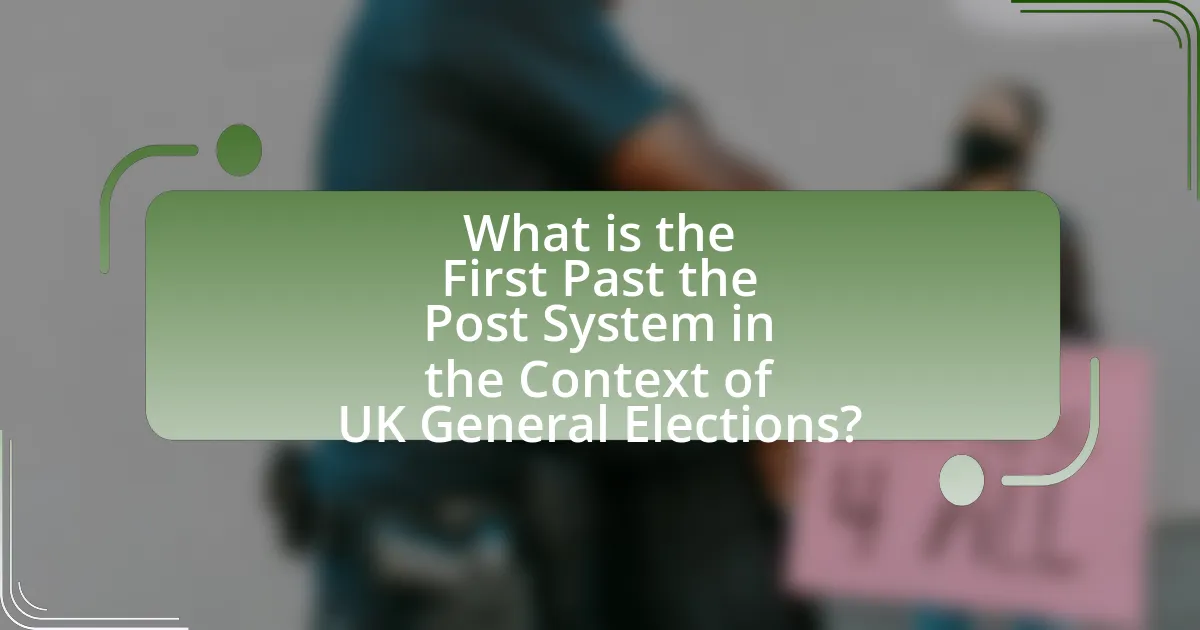
What is the First Past the Post System in the Context of UK General Elections?
The First Past the Post (FPTP) system is an electoral mechanism used in UK general elections where the candidate receiving the most votes in a constituency wins. This system operates on a simple plurality basis, meaning that a candidate does not need to achieve an absolute majority, only to have more votes than any other candidate. For instance, in the 2019 general election, Boris Johnson’s Conservative Party won 365 out of 650 seats with only 43.6% of the popular vote, illustrating how FPTP can lead to a significant disparity between the percentage of votes received and the number of seats won.
How does the First Past the Post System function in UK elections?
The First Past the Post (FPTP) system in UK elections functions by awarding victory to the candidate who receives the most votes in a constituency, without requiring a majority. In this electoral system, voters cast their vote for one candidate, and the candidate with the highest number of votes is declared the winner. For example, in the 2019 General Election, Boris Johnson’s Conservative Party won 365 out of 650 seats with only 43.6% of the popular vote, illustrating how FPTP can lead to a significant disparity between the percentage of votes received and the number of seats won. This system is characterized by its simplicity and speed in determining results, but it often results in a lack of proportional representation, as smaller parties may struggle to gain seats despite receiving a substantial share of the overall vote.
What are the key features of the First Past the Post voting method?
The First Past the Post (FPTP) voting method is characterized by its simplicity, where the candidate receiving the most votes in a constituency wins, regardless of whether they achieve an absolute majority. This method is widely used in the UK for general elections, allowing voters to select one candidate on the ballot. The key features include single-member districts, a straightforward counting process, and the potential for a winner-takes-all outcome, which can lead to disproportionate representation. For instance, in the 2019 UK general election, the Conservative Party won 365 seats with only 43.6% of the popular vote, illustrating how FPTP can result in a significant disparity between votes received and seats won.
How is a winner determined in a First Past the Post election?
In a First Past the Post election, the winner is determined by the candidate who receives the most votes in a constituency. This voting system does not require the winner to achieve an absolute majority; rather, a plurality of votes is sufficient. For example, in the 2019 UK General Election, Boris Johnson won his constituency with 43.6% of the votes, while his closest competitor received 32.1%, illustrating how a candidate can win without a majority.
What historical context surrounds the First Past the Post System in the UK?
The First Past the Post (FPTP) system in the UK originated in the 19th century, primarily established through the Representation of the People Act 1918, which expanded the electorate and formalized the electoral process. This system was influenced by earlier voting practices and was adopted to simplify the election process, allowing the candidate with the most votes in a constituency to win, rather than requiring a majority. The historical context includes the gradual democratization of British politics, marked by reforms such as the Reform Acts of 1832, 1867, and 1884, which progressively extended voting rights to broader segments of the population. The FPTP system has since shaped the political landscape, leading to a predominance of two major parties, the Conservative and Labour parties, and has been a subject of debate regarding its fairness and representation.
When was the First Past the Post System first implemented in the UK?
The First Past the Post System was first implemented in the UK in 1832. This electoral system was introduced with the Representation of the People Act 1832, which aimed to reform the electoral process and expand the electorate. The act marked a significant change in how parliamentary elections were conducted, establishing the basis for the voting system still in use today.
What changes have occurred in the electoral system over time?
The electoral system in the UK has undergone significant changes over time, particularly with the introduction and evolution of the First Past the Post (FPTP) system. Initially, the electoral process was limited to a small segment of the population, primarily wealthy landowners, but reforms such as the Reform Acts of 1832, 1867, and 1884 expanded the electorate to include more working-class men and eventually women, culminating in the Representation of the People Act 1918, which granted suffrage to all men over 21 and women over 30.
The FPTP system itself has remained largely unchanged since its adoption in the 19th century, where the candidate with the most votes in a constituency wins, leading to a tendency for a two-party system. However, the introduction of proportional representation in certain elections, such as the Scottish Parliament and Welsh Assembly elections, reflects a shift towards more inclusive electoral practices. Additionally, the 2011 Alternative Vote referendum attempted to reform the FPTP system but was ultimately rejected by voters, indicating ongoing debates about electoral fairness and representation.
These changes illustrate a gradual expansion of democratic participation and ongoing discussions about the effectiveness and fairness of the electoral system in representing the diverse views of the UK electorate.
What are the main criticisms of the First Past the Post System?
The main criticisms of the First Past the Post (FPTP) system include its tendency to produce unrepresentative outcomes, disenfranchisement of voters, and the encouragement of tactical voting. FPTP often leads to a significant disparity between the percentage of votes received by a party and the percentage of seats they secure in Parliament; for example, in the 2015 UK General Election, the Conservative Party won 51% of the seats with only 37% of the popular vote. This disproportionality can marginalize smaller parties, as seen with the Liberal Democrats, who received nearly 8% of the vote but only secured 2% of the seats. Additionally, FPTP can discourage voter participation, as individuals in safe seats may feel their votes carry less weight, leading to lower turnout rates; the 2019 election saw a turnout of just 67.3%. Lastly, tactical voting emerges as voters may choose not their preferred candidate but the one most likely to win against an undesirable candidate, further distorting true voter preferences.
Why do some argue that it leads to disproportionate representation?
Some argue that the First Past the Post (FPTP) electoral system leads to disproportionate representation because it allows candidates to win seats without securing a majority of votes. In the 2019 UK General Election, for example, the Conservative Party won 365 seats with only 43.6% of the popular vote, while the Liberal Democrats received 11.5% of the vote but only won 11 seats. This discrepancy illustrates how FPTP can result in a significant mismatch between the percentage of votes received and the number of seats allocated, favoring larger parties and marginalizing smaller ones.
How does the system affect voter turnout and engagement?
The First Past the Post (FPTP) system significantly affects voter turnout and engagement by creating a perception of wasted votes, which discourages participation. In elections where only a plurality is needed to win, voters in constituencies with a strong majority party may feel their votes do not contribute to the outcome, leading to lower turnout rates. For instance, the Electoral Commission reported that voter turnout in the 2019 UK General Election was 67.3%, which is lower than in proportional representation systems where every vote has a greater impact on the overall result. Additionally, the FPTP system can lead to voter apathy, as individuals may believe their preferences are unlikely to influence the election outcome, further diminishing engagement.
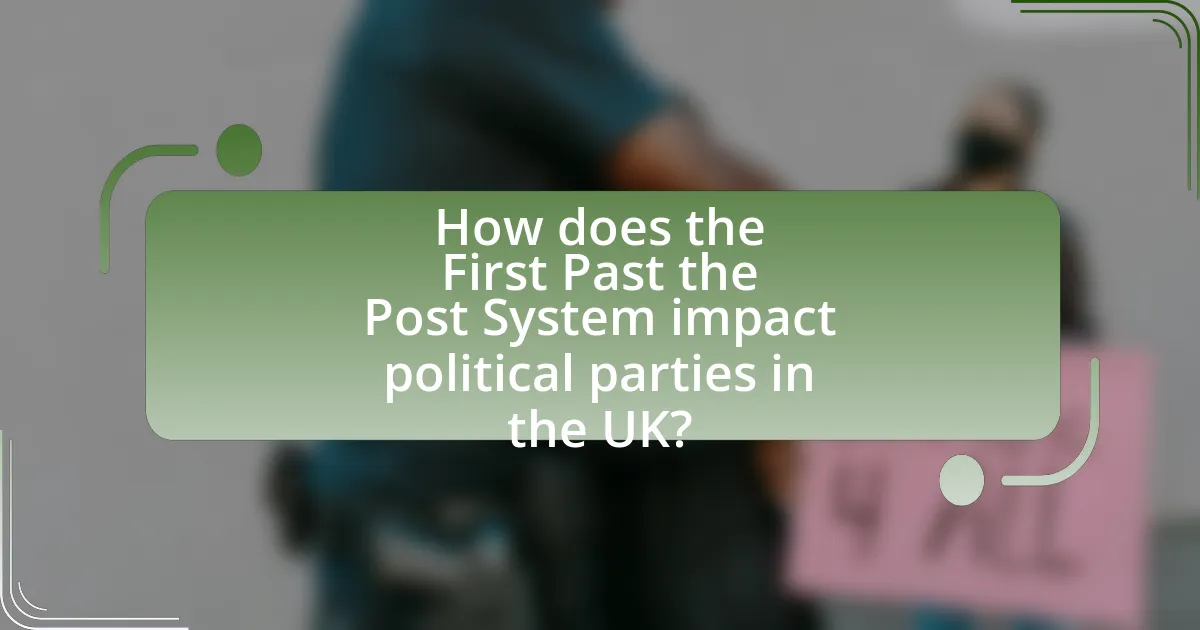
How does the First Past the Post System impact political parties in the UK?
The First Past the Post (FPTP) system significantly impacts political parties in the UK by favoring larger parties and often leading to a disproportionate representation in Parliament. Under FPTP, the candidate with the most votes in a constituency wins, which can result in a situation where a party receives a majority of seats without a majority of the overall vote. For example, in the 2019 general election, the Conservative Party won 365 seats with only 43.6% of the popular vote, illustrating how FPTP can distort the relationship between votes received and seats gained. This system discourages smaller parties, as they struggle to win seats despite potentially significant overall support, leading to a two-party dominance, primarily between the Conservatives and Labour. Consequently, FPTP shapes party strategies, often compelling smaller parties to form alliances or focus on specific regional issues to gain traction.
What advantages does the First Past the Post System provide to certain political parties?
The First Past the Post (FPTP) system advantages certain political parties by enabling them to secure a majority of seats with a plurality of votes, often benefiting larger parties. This electoral system allows parties with concentrated support in specific regions to win a disproportionate number of seats compared to their overall vote share. For example, in the 2019 UK General Election, the Conservative Party won 365 seats with only 43.6% of the popular vote, illustrating how FPTP can amplify the representation of dominant parties while marginalizing smaller parties. This effect can lead to a stable government, as seen in the same election, where the Conservatives achieved a decisive majority, allowing for more straightforward governance and policy implementation.
How does the system favor larger parties over smaller ones?
The First Past the Post (FPTP) electoral system favors larger parties over smaller ones by allowing candidates to win seats in Parliament by securing the most votes in a constituency, rather than requiring a majority. This often results in larger parties receiving a disproportionate share of seats relative to their overall vote percentage. For example, in the 2019 UK General Election, the Conservative Party won 365 seats with only 43.6% of the vote, while smaller parties like the Liberal Democrats received 11.5% of the vote but only won 11 seats. This disparity occurs because smaller parties struggle to gain a foothold in multiple constituencies, leading to wasted votes in areas where they cannot win.
What role does party organization play in electoral success under this system?
Party organization is crucial for electoral success under the First Past the Post system in the UK. A well-structured party organization enables effective candidate selection, resource allocation, and voter mobilization, which are essential for winning a plurality of votes in single-member constituencies. For instance, the Conservative Party’s strong local associations and grassroots campaigning have historically contributed to their electoral victories, as seen in the 2019 General Election where they secured 365 seats, largely due to their organized ground game and targeted messaging. This demonstrates that robust party organization directly influences the ability to convert voter support into electoral success within this electoral framework.
What disadvantages do political parties face under the First Past the Post System?
Political parties face significant disadvantages under the First Past the Post (FPTP) system, primarily due to the winner-takes-all nature of electoral districts. This system often leads to a disproportionate representation where parties can receive a substantial share of the overall vote but win few or no seats in Parliament. For instance, in the 2015 UK General Election, the UK Independence Party garnered 12.6% of the vote but secured only one seat, illustrating how FPTP can marginalize parties that do not have concentrated support. Additionally, FPTP encourages tactical voting, where voters may choose a less preferred candidate with a better chance of winning, further distorting true voter preferences and undermining smaller parties. This system can also result in a lack of diversity in political representation, as larger parties dominate the electoral landscape, making it challenging for new or smaller parties to gain traction.
How can smaller parties struggle to gain representation?
Smaller parties struggle to gain representation primarily due to the First Past the Post (FPTP) electoral system used in UK General Elections. This system awards seats to candidates who receive the most votes in individual constituencies, often leading to a disproportionate allocation of parliamentary seats relative to the overall vote share. For instance, in the 2019 General Election, the Liberal Democrats received 11.5% of the national vote but secured only 1.7% of the seats, illustrating how smaller parties can be significantly underrepresented. Additionally, the winner-takes-all nature of FPTP discourages voters from supporting smaller parties, as they may perceive their votes as wasted in constituencies where larger parties dominate.
What impact does the system have on coalition-building among parties?
The First Past the Post (FPTP) system significantly limits coalition-building among parties. This electoral system often leads to a clear winner with a majority of seats, discouraging smaller parties from forming alliances, as they are less likely to gain representation. For instance, in the 2019 UK General Election, the Conservative Party won 365 out of 650 seats with only 43.6% of the popular vote, illustrating how FPTP can create a dominant party scenario that reduces the incentive for coalition formation. Consequently, parties may focus on winning outright rather than collaborating, which can lead to a fragmented political landscape where diverse viewpoints are underrepresented.
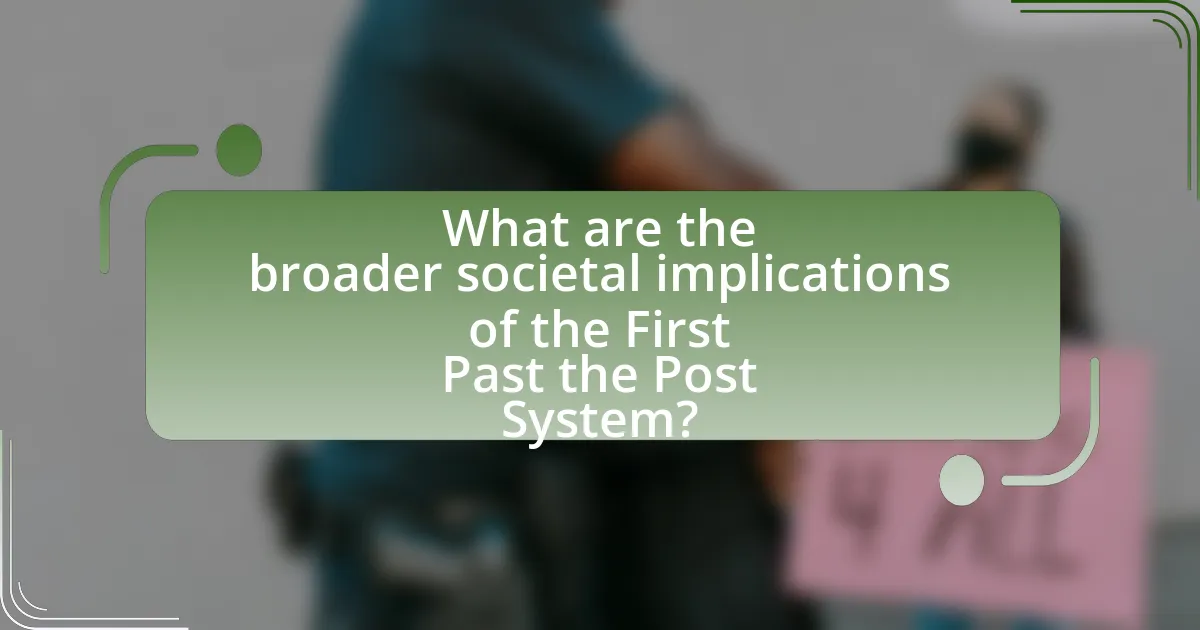
What are the broader societal implications of the First Past the Post System?
The First Past the Post (FPTP) system leads to significant societal implications, primarily fostering a two-party system that marginalizes smaller parties and reduces voter choice. This electoral structure often results in a lack of proportional representation, where the distribution of seats in Parliament does not reflect the overall vote share, as evidenced by the 2019 UK General Election, where the Conservative Party won 365 seats with only 43.6% of the vote. Consequently, this can lead to voter disenfranchisement, as individuals may feel their votes carry less weight if they support a less popular party. Additionally, FPTP can exacerbate regional disparities, as parties may focus on winning in specific areas rather than addressing national issues, further entrenching divisions within society.
How does the First Past the Post System influence voter behavior?
The First Past the Post (FPTP) system influences voter behavior by encouraging strategic voting, where individuals may choose not to vote for their preferred candidate to avoid wasting their vote. This occurs because voters often perceive that only candidates with a realistic chance of winning can affect the election outcome. For example, in the 2019 UK General Election, many voters opted for the Conservative Party or Labour Party, believing that smaller parties had little chance of winning, which led to a significant concentration of votes among the leading parties. This behavior is further supported by studies indicating that FPTP can lead to a two-party system, as seen in the UK, where the majority of seats are won by just two parties, reinforcing the notion that voting for third parties is less impactful.
What psychological effects does the system have on voters’ choices?
The First Past the Post (FPTP) system significantly influences voters’ choices by creating a perception of wasted votes, which can lead to strategic voting. Voters often feel compelled to support candidates they perceive as having a realistic chance of winning, rather than their preferred candidates, to avoid contributing to a loss. This phenomenon is supported by research indicating that in FPTP elections, approximately 30% of voters express dissatisfaction with their choices, as they prioritize electability over personal preference. Additionally, the system fosters a two-party dominance, which can psychologically discourage third-party support, reinforcing the belief that only major parties can win. This dynamic can lead to voter apathy and disengagement, as individuals may feel their votes do not matter in a system that favors larger parties.
How does the system affect public perception of political efficacy?
The First Past the Post (FPTP) electoral system significantly affects public perception of political efficacy by creating a sense of disenfranchisement among voters. Under FPTP, the winner-takes-all approach often leads to a concentration of power in a few dominant parties, which can result in many voters feeling that their votes carry little weight, especially in constituencies where one party is overwhelmingly favored. Research indicates that this perception is linked to lower voter turnout; for example, the Electoral Commission reported that turnout in the 2019 UK General Election was 67.3%, a decline from previous elections, suggesting that many citizens feel their participation is futile. Consequently, the FPTP system can diminish the belief that individual votes matter, thereby reducing overall political efficacy among the electorate.
What are the potential reforms to the First Past the Post System?
Potential reforms to the First Past the Post (FPTP) system include the introduction of proportional representation, ranked-choice voting, and the establishment of multi-member constituencies. Proportional representation would allocate seats based on the percentage of votes received, addressing the issue of wasted votes and ensuring that minority parties gain representation. Ranked-choice voting allows voters to rank candidates in order of preference, which can lead to more representative outcomes by ensuring that elected officials have broader support. Multi-member constituencies would enable multiple representatives to be elected from a single area, further enhancing proportionality and reducing the dominance of major parties. These reforms aim to create a more equitable electoral system, as evidenced by various studies indicating that FPTP often leads to significant disparities between the percentage of votes received and the number of seats won by parties.
What alternative voting systems are proposed for the UK?
Alternative voting systems proposed for the UK include the Single Transferable Vote (STV), the Alternative Vote (AV), and the Additional Member System (AMS). The Single Transferable Vote allows voters to rank candidates in order of preference, promoting proportional representation. The Alternative Vote system enables voters to rank candidates, with the least popular candidates eliminated in rounds until one achieves a majority. The Additional Member System combines first-past-the-post with proportional representation, allowing voters to cast two votes: one for a constituency candidate and another for a party list. These systems aim to address the perceived shortcomings of the First Past the Post system, which can lead to disproportionate representation and wasted votes.
How could reforms change the political landscape in the UK?
Reforms could significantly alter the political landscape in the UK by introducing proportional representation, which would ensure that the distribution of seats in Parliament more accurately reflects the votes cast by the electorate. Currently, the First Past the Post system often leads to a disproportionate representation, where smaller parties struggle to gain seats despite receiving substantial public support. For instance, in the 2019 general election, the Liberal Democrats received 11.5% of the vote but only secured 1.8% of the seats. Implementing reforms such as a mixed-member proportional system could enhance voter engagement, reduce wasted votes, and encourage a more diverse range of political parties to participate in the electoral process, thereby fostering a more representative democracy.
What practical considerations should voters keep in mind regarding the First Past the Post System?
Voters should consider that the First Past the Post (FPTP) system often leads to a disparity between the percentage of votes received and the number of seats won. This system allows a candidate to win by securing the most votes in a constituency, even if they do not achieve an absolute majority. For instance, in the 2019 UK General Election, the Conservative Party won 43.6% of the popular vote but secured 365 out of 650 seats, illustrating how FPTP can distort representation. Additionally, voters should be aware that tactical voting may be necessary; they might need to vote for a less preferred candidate who has a better chance of winning against a candidate they oppose. This can lead to strategic decision-making rather than voting for their true preference.

